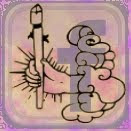
In this entry you are going to be learning how to apply copper foil to the pieces of glass that you just cut out from your pattern pieces. For this process you will need your roll of 7/32” black backed copper foil and a sharp straight edge. I find packages of straight edges at my local Dollar Store that are usually 5 for $1.00, but you can use any straight edge you have as long as it will cut the copper foil.
The next hi-tech tool I use is a crimper with a roller attached to it. There are several different brands on the market, I use a Foil Burnisher with Edge Smoother Handle from "Anything in Stained Glass". If you are just starting out and need to save your money for the more costly purchases stained glass has you can use half of a wooden clothes pin. Just remove the metal spring in the middle and you have one to use and a spare for later.
Hold your copper foil in your left hand, paper side up, foil side down. With the foil end pointing away from you peel the paper back about two inches, now take a piece of glass and turning it on its side center the last 1/4 inch of the end onto the copper foil and press it into the foil, then continue centering the copper foil down the next side of glass, pressing and peeling as you go. **Note: The first side of glass will only have the 1/4 inch piece of tape on it until you finish it as instructed below. This procedure ensures a complete circle of tape with no open ends.** Follow this process all the way around the glass until you get to your original 1/4 inch piece of copper foil. Once you get to the side you started on continue your copper foil down that side covering your original 1/4 inch piece of copper foil and taking the foil to the end of the piece of glass then use your straight edge to cut it even with the edge of the glass.
Once your copper foil has been cut take your burnisher or wooden clothes pin and burnish (softly rub) the edges of the glass all the way around. When completed, then take your crimper and run the groove of your crimper around your entire piece. If you only have a wooden clothes pin you will not be able to crimp; however, you can gently rub the edges of your piece (on both sides) with the clothes pin to help smooth the foil down for better coverage. Now lay your piece down flat and using the roller roll your edges flat on both sides. Don’t get sloppy on this step, when you hit it with a hot iron it will show here first!
Now it’s at this point that I always take a wooden clothes pin and gently burnish the edges down flatter. This helps with assuring they do not lift up once I start to solder. It’s taking time to do the small detail work now that will pay off in less headaches later on. Here's a video that will help with some of it.
That’s it for foiling your glass pieces. Was it as hard as you thought? Well next time we’ll begin our venture into soldering. We’ll start out with tinning, then move into tack soldering. So remember to keep your eye on the prize and keep thinking about all the beautiful things your going to make after you learn The Art Of Stained Glass 101!
































